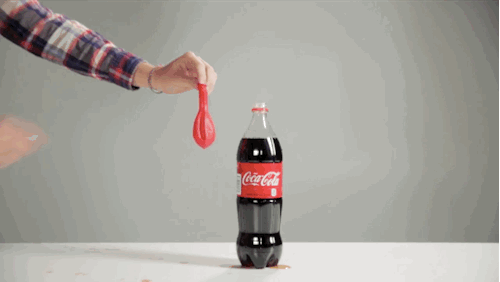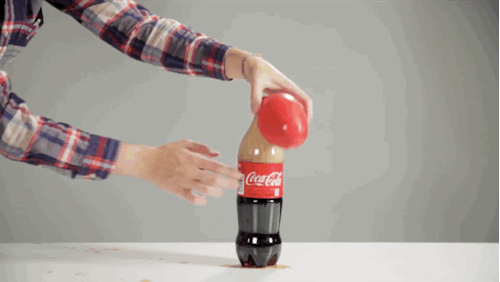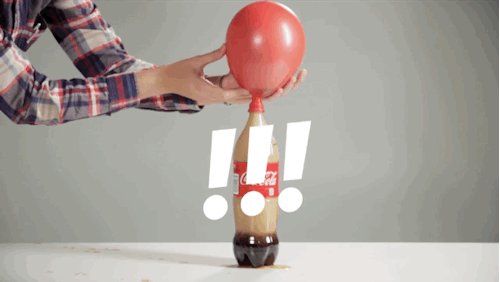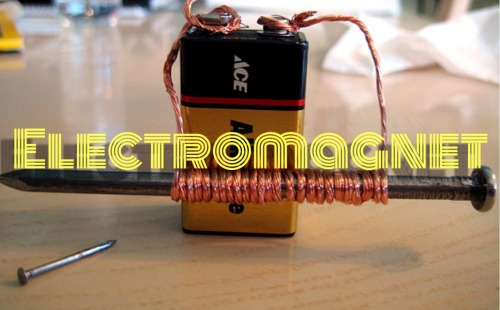Materials: 1.4 Soda Cans 2.2 Ceramic Magnets 3.ruler 4. Five Hex Nuts 5.an Empty Tall Drinking Glass

Materials: 1.4 soda cans 2.2 ceramic magnets 3.ruler 4. Five hex nuts 5.an empty tall drinking glass 6.adult Steps: 1.First, put two soda cans on each side at the ruler length apart. 2.next, stack the other two soda cans with one on each can. 3.then, put the ruler on top of the soda can towers and put The drinking glass between the towers. 4.next, place one magnet on the ruler and put the other magnet underneath the ruler so the magnets attached to each other. 5.then, attach the hex nuts with one of the time to the magnet underneath the ruler 6.finally, slowly detach the hex nut chain and bounce it on the edge of the glass. (Make sure the edge is directly below the magnet) Lesson: The magnets are causing the hex nuts to attract each other, and, thus, the hex nuts create their own magnetic field. When you detach the hex nuts from the magnet, there magnetic field is weaker.
More Posts from Funscienceexperiments and Others

Poor virus feels left out!

Materials: 1. Water 2. A clear plastic bottle with a cap 3. Dish washing soap 4. Glitter
Steps: 1. First, fill the bottle until it reaches 3 quarters full 2. Next, add 3 drops of dish washing soap in the bottle. 3. Then, sprinkle in 3 pinches of glitter. 4. Next, put the cap on tightly 5. Finally, turn the bottle upside down. And hold it by the neck. Quickly, spin the bottle in a circular motion for 10 seconds and stop to see a mini tornado in your bottle.
Lesson: When you spin the bottle, it creates a water vortex. The water is spinning around the center of the vortex because of centripetal force. Centripetal force is an inward force directing an object or fluid towards the center of its circular path. Examples of natural vortexes are tornadoes, hurricanes, and waterspouts.







How To Create Electricity From Falling Water
You can generate sparks of 5,000 to 10,000 volts of electricity using only two streams of water and metal mesh. Want to replicate the experiment at home? See how… http://bit.ly/1rxaoKJ

Today’s Illustrated Women in History is a written submission by James Purvis.
Caroline Herschel 1750 - 1848
Caroline Herschel was an astronomer and singer, and was the first woman to be paid for her contribution to science.
At the age of 22 Herschel, who had received training in music against the wishes of her mother, left her home in Hanover to join her brother William, who had established himself as an Organist in Bath, England. Herschel soon distinguished herself by becoming the principal singer in her brother’s Oratorio concerts, and received offers to perform across the country.
Alongside his musical career, William Herschel’s interest in astronomy grew, and with the assistance of Herschel he was eventually offered the position of court astronomer to King George III. At this time, Herschel chose to leave her singing career and become her brother’s scientific assistant, although some of her later writings suggest that this was perhaps not an easy decision.
Her skill as an astronomer was formidable, and in her obituary, the Royal Astronomical Society praised her ‘indefatigable zeal, diligence and singular accuracy of calculation’ as being significant contributors to her brother’s astronomical success. Herschel was awarded a salary by the court as an assistant astronomer, becoming the first woman to be paid as a scientist.
Her work included the grinding of mirrors for reflecting telescopes, taking observations of stretches of the sky, and detailing the precise timings and positions of the observed astronomical objects, as well as a great deal of calculation in order to translate these times and positions into usable data.
Between the assistance that she rendered to her brother’s work, Herschel found time for her own research, discovering a number of comets, as well as previously unobserved nebulae and star clusters, and compiling catalogues of the stars.
Herschel was awarded the Gold Medal of the Royal Astronomical Society, and was later made an honorary member. Today, she is commemorated by a crater on the moon which is named after her.
If you would like to submit a biography of a woman in history to be illustrated and featured, please send me a message!

Materials: 1. A D size battery 2. Paper clips 3. 3 feet of thin coated copper wire 4. A 3 inch large iron nail
Steps: 1. First, leave 8 inches of wire at one end and wrap most of the rest of the wire on the nail ( do not overlap the wires). 2. Next, leave 8 inches of wire at the other end of the nail. 3. Then, remove an inch of the plastic coating from both ends of the wire and attach one end of the wire to one end of the battery and the other wire to the other end of the battery. 4. Finally, put the nail near the paper clips and it should pick them up!
Lesson: Magnets that cannot be turned off like ones on our refrigerators are called permanent magnets. Since the magnet we made can be turned off and on, it is known as an electromagnet. They run on electricity and are only magnetic when the electricity is flowing through the wires, which has the molecules in the nail attract to the metal paper clips.

Bill Nye, “The Science Guy”, has some great “home demos” which could certainly be used in the classroom, along with some printable “one sheets”.
#scichat #spedchat #elemchat
Home Demos are found in three categories; life sciences, physical sciences, planetary sciences.
I have added these to Super Science Fair Project Resources
You may also like…
The Surfing Scientist
Hunkin’s Experiments
Windows to the Universe
Welcome to Cosmic Quest
This is what it looks like when you use warm water to dispose of a little bit of liquid nitrogen on your roof terrace.




This is what happens when you put molten salt into water - Full video
-
 colorfulcollectorpirate liked this · 2 years ago
colorfulcollectorpirate liked this · 2 years ago -
 funscienceexperiments reblogged this · 8 years ago
funscienceexperiments reblogged this · 8 years ago -
 vintage-cate liked this · 9 years ago
vintage-cate liked this · 9 years ago -
 funscienceexperiments reblogged this · 9 years ago
funscienceexperiments reblogged this · 9 years ago
Hi everyone! I'm Ashley P. and I'm a Girl Scout who wants to make a difference in the world. Currently, I've been working on my Gold Award Project, which is a project where Girl Scouts solve an issue in their community to earn the Gold Award. The Gold Award is the highest award a Girl Scout can achieve. In my project, I'm addressing the issue on how there are a lack of women in the STEM field by creating a program to do fun science experiments with younger girls. Also, I constructed this blog for parents and children to do exciting and simple experiments with their kids to spark a passion in this subject like what happened to me as a child. I hope you enjoy and try to accomplish the experiments I post! Also, please have adult supervision while completing these experiments.
210 posts